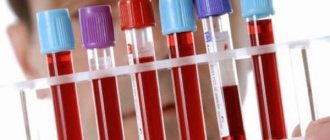What is RFMC?
RFMC is not prescribed as a separate analysis. Fibrin-monomer complexes are determined during a hemostasiogram. They are assigned and taken into account in conjunction with other indicators:
- fibrinogen;
- INR;
- APTT;
- PTI;
- D-dimer;
- lupus anticoagulant, etc.
RFMK is normally present in the blood of every person. In clinical practice, the growth of the indicator is important. A decrease in RFMC is rare and is usually associated with irrational use of medications that affect hemostasis.
What kind of analysis is this
- have a hearty dinner the night before, it is recommended to drink a cup of tea or kefir as late as possible, but try to do it before 22-00;
- Don’t have breakfast in the morning, don’t drink, don’t satisfy your hunger with cigarettes, be patient, you can donate blood only on an empty stomach;
- stop taking medications (even folk remedies) that thin the blood one day before the study, otherwise the RKFM values will be distorted;
- for 2-3 days before the analysis, do not overwork, if possible, eliminate physical activity, avoid stress and strong emotional outbursts.
Results can be found out on the same day or within 2-3 days.
If the blood test shows a positive result for the fibrin monomer RKMF, this means an increase in the level of the RKMF norm.
The result may show a negative value during pregnancy, which is an ideal indicator of normality for RFMC. In this case, you can relax, there is no reason to worry.
How many tests will be performed depends on how serious RFMCs during pregnancy show deviations from the norm.
If the fibrin level is slightly too high or too low, the test is usually performed no more than once or twice.
In cases where the test results show a very high RFMC in the blood, the doctor may prescribe the woman to undergo the procedure several times.
The pregnant woman’s condition is under constant medical supervision; the test is performed several times throughout the pregnancy.
Indications for examination during pregnancy
Regarding the hemostasiogram (and RFMC), experts did not come to a consensus. Some gynecologists say that a hemostasiogram is not a routine examination method. They warn that there is no point in prescribing screening for RFMC and other indicators of the blood coagulation system for all pregnant women. It is recommended to donate blood only if indicated:
- pregnancy planning against the background of risk factors for pathology of the hemostatic system: hereditary thrombophilias, previous spontaneous miscarriages, regressing pregnancy;
- threat of termination of a real pregnancy at any stage;
- placental insufficiency and disruption of uteroplacental blood flow;
- delayed fetal development;
- gestosis;
- multiple pregnancy;
- pregnancy after IVF;
- delayed fetal development;
- vaginal bleeding during pregnancy;
- phlebeurysm;
- heart defects;
- obesity;
- diabetes;
- smoking during pregnancy;
- autoimmune diseases;
- changes in the coagulogram indicating increased blood clotting.
Other gynecologists say that not all pathology occurs clearly, and it is often difficult to identify the problem in the early stages of its development. They suggest testing blood clotting in all pregnant women twice:
- in the first trimester or at the first visit to the doctor;
- after 30 weeks.
In the early stages, assessment of RFMC allows to identify serious hemostatic disorders leading to spontaneous miscarriage or regression of pregnancy. In the third trimester, the analysis makes it possible to detect other disorders associated with a natural decrease in blood during gestation. This approach allows you to detect hidden problems and prevent the development of complications before they manifest.
Since a unified approach has not yet been developed, many gynecologists adhere to the golden mean - they prescribe a blood test for RFMK in the presence of risk factors and abnormalities in a simple coagulogram.
Which doctor should I take a test to determine the level of RFMC?
The initial examination and consultation is carried out by a general practitioner. Based on the survey and medical history, the doctor draws up an individual examination program during pregnancy.
To determine the main indicators, it is necessary to donate blood to a coagulogram.
In addition to the RFMK level, the following parameters are studied:
- plasma fibrinogen;
- ATTT (activated partial thromboplastin time);
- lupus coagulant - its appearance can provoke termination of pregnancy;
- thrombin time (TT);
- for blood clotting, antistreptolysin (or ASLO blood test) is examined - antistreptolysin antibodies in the blood indicate a 100% probability that the body is infected due to the presence of streptococcus;
- an increase in prothrombin in the blood and a decrease in antithrombin - even a small fraction of deviations can threaten placental abruption.
To establish a more accurate diagnosis and results of RFMC, values by week and trimester are taken into account. An additional scale for measuring RFMC in seconds is used.
Only with positive emotions
A normal RFMC level of 5.1 mg corresponds to 4 5 - 5 4 (plus or minus) seconds.
Therefore, if in conclusion there are high values, RFMK 12, RFMK 16 (or 11 26 10 13 24, etc.), then do not be alarmed. Perhaps these measurements were taken on a time scale and are normal.
Preparing for the examination
RFMK is determined in the patient’s peripheral blood. Rules for taking the analysis:
- Blood is taken from a vein.
- It is recommended to take a hemostasiogram on an empty stomach in the morning after an 8-hour fast. You can drink water on the day of the examination.
- Two weeks before donating blood, you need to stop taking medications that affect the hemostasis system (in consultation with your doctor). If this is not possible, the woman should inform the nurse who takes the blood - she will note this information on the form. The interpretation of the results will be carried out taking into account the medications taken by the patient.
- The day before the examination, you should avoid physical and emotional stress.
- Two hours before donating blood, you should refrain from smoking.
- You cannot donate blood immediately after an ultrasound, x-ray, physical therapy or other medical procedures.
- The control study must be carried out in the same laboratory under the same conditions.
A blood test for RFMK is prescribed by a gynecologist or therapist. The doctor interprets the results taking into account the clinical picture of the disease and the woman’s complaints. No need to treat analysis! If the results obtained seem questionable and do not fit into the clinic, it is worth undergoing a re-examination.
Risk group
Women who have the following diseases should be subject to more careful monitoring of RFMC levels:
- purulent inflammation;
- autoimmune diseases;
- diabetes;
- varicose veins;
- cardiovascular diseases;
- neoplasms;
- there is a history of miscarriages or premature births;
- placental dysfunction.
Special monitoring is required during multiple pregnancies, during IVF and in women who have relatives with thrombophilia or other bleeding disorders.
Decoding the results and assessing the level of RFMK
The norm of RFMC outside pregnancy is up to 4 mg/100 ml. The lower limit of normal has not been established. A sharp decrease in fibrin-monomer complexes may indicate pathology, but the indicator must be assessed over time.
During pregnancy, the state of the hemostatic system changes, and the natural growth of RFMC occurs. This is due to several factors:
- the emergence of a new blood circulation (fetal cardiovascular system);
- increase in circulating blood volume;
- platelet levels increase slightly;
- the concentration of some blood clotting factors increases (VII, VIII, X);
- There is an increase in fibrinogen in the blood plasma.
All these factors affect the level of RFMC and lead to its slight increase during gestation. Physiological hypercoagulation develops - a condition in which the blood clots faster. This is necessary for normal implantation of the fertilized egg into the uterine wall and development of the placenta. Physiological hypercoagulation is also needed to stop bleeding during childbirth.
Blood counts change throughout pregnancy and return to normal only after childbirth. These changes are physiological - they are necessary for the normal development of the fetus. But if the level of RFMC changes significantly and exceeds the norm accepted for pregnancy, it is worth thinking about the development of complications. All those factors that lead to physiological hypercoagulation can cause thrombosis.
The norm of RFMC depends on the stage of pregnancy and is about 5 mg/100 ml. It is customary to focus on the following indicators:
- I trimester – up to 5 mg/100 ml;
- II trimester – up to 6 mg/100 ml;
- III trimester – up to 7 mg/100 ml.
When deciphering indicators, you need to take into account laboratory standards. The technique used to evaluate the material may vary, and this will affect the results of the examination.
Why is RFMC analysis needed during pregnancy?
Changes in hemostasis during pregnancy contribute to an increase in the level of soluble fibrin-monomer complex (SFMC - small particles of blood clots that form as a result of extensive thrombosis) in a woman’s body.
This is a normal phenomenon during pregnancy, but an excess or lack of fibrin can cause circulatory problems in the body. If the problem is not detected in time and you do not undergo blood-thinning therapy, the risk of premature birth or death of the child increases significantly.
In addition, this can lead to other negative consequences:
- dysfunction of the placenta or its early aging;
- abortion;
- fetal hypoxia;
- developmental defects;
- pathological childbirth;
- the formation of a blood clot in the umbilical cord - this, unfortunately, always leads to the death of the fetus.
That is why at this time it is so important to monitor the level of RFMC and, if any deviations are detected, to immediately take the necessary measures. The test for the RFMC norm must be taken several times during pregnancy. It is prescribed at different periods - 10, 11, 12, 13, 14, 15, 17-19, 22-28, 32-36 weeks and sometimes even later.
Raising RFMK
The growth of RFMK above the norm established for a certain period of pregnancy indicates a strengthening of the coagulation system. Blood clots faster, and blood clots can form on the walls of blood vessels. This condition may be due to various reasons:
- Hereditary pathology of the hemostatic system. To confirm the diagnosis, you need to undergo an additional examination - donate blood for D-dimer and other markers of genetic abnormalities. Hereditary thrombophilias may not manifest themselves in any way before pregnancy or may make themselves felt by individual symptoms (frequent nasal and uterine bleeding, rapidly forming hematomas, etc.). Often, changes in the blood coagulation system are detected only during pregnancy or in preparation for conceiving a child. They cause infertility, lead to spontaneous miscarriage in the first and second trimesters, and premature birth after 22 weeks. Hereditary anomalies of the hemostatic system are considered one of the causes of regressive pregnancy, disruption of uteroplacental blood flow, and delayed fetal development.
- Conditions associated with a high risk of thrombosis: varicose veins, coronary heart disease, heart defects, autoimmune diseases, diabetes mellitus, purulent inflammation of various locations. These processes often occur even before the child is conceived. During pregnancy, the risk of exacerbation of pathology and the development of thromboembolic complications increases. An increase in RFMK indicates that the process has started, and there is a high probability of blood clots forming in the vessels against the background of the underlying disease.
- Conditions associated with disseminated blood coagulation. During pregnancy, the growth of RFMK is a marker of gestosis. With this pathology, the risk of thrombosis, bleeding, and death of the woman and fetus as a result of vascular disorders increases.
- Consequences of previous injuries and operations. After damage to the skin, the blood coagulation system is activated, and RFMK grows. A significant increase in the indicator indicates a high risk of thrombosis.
- Malignant tumors. An increase in RFMK may be associated with the growth or disintegration of neoplasms of any location.
What threatens deviations from the norm in RFMC indicators during pregnancy?
When a woman is carrying a child, any deviations in RFMC - decrease or increase - are fraught with the development of pregnancy pathology.
Impaired hemostasis can lead to the development of bleeding and thrombophilia, which is a very dangerous disease. This can become a threat to the life of both mother and child.
Significant deviations in RFMC indicators can be caused by:
- placental abruption;
- fetal freezing;
- premature birth;
- fetal hypoxia;
- the formation of blood clots, which can be fatal.
If fibrinogen and rfmk are increased during pregnancy, depending on the degree of their severity, the following may develop:
- Impaired placental-uterine circulation and, as a result, fetal hypoxia develops;
That is, the child suffers from a lack of oxygen, which causes a disruption in the flow of all biochemical processes in his body. The brain especially suffers from oxygen deficiency;
- Oxygen deficiency leads to abnormalities in fetal development, which sometimes become so critical that the fetus loses viability and dies;
Spontaneous abortion occurs or, in later stages, the condition requires auxiliary obstetric measures for delivery of a dead fetus;
- Dysfunction of the placenta, up to its abruption and the occurrence of vaginal bleeding with the threat of developing disseminated intravascular coagulation syndrome. This condition seriously threatens the life of the mother;
- Thrombosis in the vessels of the umbilical cord, acute fetal hypoxia, which can provoke its sudden death.
The attending physician, if deviations from the norm are detected, knows exactly how to reduce the risks for the mother and fetus in any situation.
Congenital pathology in children born to mothers with elevated RFMC values during pregnancy:
- Weak, lethargic and underweight child;
- Heart defects;
- Disorders of brain development with all the ensuing consequences.
With reduced RFMC values, women may experience placental abruption and massive bleeding.
An increase in RFMK during pregnancy planning can provoke miscarriages in the early stages, and sometimes becomes a cause of infertility. When planning pregnancy, a woman with a deviation in the level of RFMC from the norm must undergo treatment in order to normalize its level before conception.
Decrease in RFMK
A fall in RFMC is rare and is usually associated with irrational medication use. Exceeding the dosage of drugs that affect the blood coagulation system can lead to changes in indicators. RFMC should decrease while taking medications, but remain within normal limits (about 5 mg/100 ml). A fall in RFMC below the level characteristic of pregnancy (less than 4 mg/100 ml) can lead to the development of complications:
- premature placental abruption and the development of bleeding during pregnancy;
- excessive blood loss during childbirth and the postpartum period.
Bleeding is dangerous to a woman’s life and can lead to fetal death during pregnancy or childbirth.
RFMC norms for pregnant women by trimester
There are certain norms for RFMC indicators in pregnant women. In cases where the analysis shows their increase or decrease, surgical medical intervention and correction with special drugs, which are prescribed exclusively by the doctor, are required.
What are the acceptable levels of fibrin in each trimester of pregnancy:
- In the first trimester, the placenta is not yet fully formed, so the indicators are practically no different from the norms that occur in non-pregnant women. In the absence of pathologies, thrombinemia markers should not exceed 5.5 mg/100 ml of blood (in non-pregnant women - 5 mg/100 ml of blood).
- In the second trimester, the levels increase slightly, normally up to 6.5 mg/100 ml of blood. This is explained by the fact that before 16 weeks of gestation, the placenta matures and begins to fully function. The work of the uteroplacental and fetal-placental blood flow also begins, which causes an increase in blood viscosity.
- In the last trimester, levels can reach 7.5 mg/100 ml of blood. At this time, the placenta is already beginning to age and homeostasis, as if “anticipating” blood loss in the near future, begins to work in an enhanced mode.
In addition to the level of the soluble complex in plasma, other factors are also of great importance, including the so-called D-dimer. This is a protein that is formed during the breakdown of fibrins. The level of D-dimer indicates the activity of the system that is responsible for blood clotting and the destruction of blood clots that form in it. The higher the indicator, the faster they appear. Therefore, in most cases, doctors evaluate tests for RFMK and D-dimer in combination.
A doctor should decipher the tests, since different laboratories may use different units of measurement for these markers.
Tactics when changing the RFMK
When RFMK increases, drugs that affect the blood coagulation system are prescribed:
- Anticoagulants (low molecular weight heparins): Fraxiparine, Fragmin, Clexane. They affect the activity of blood clotting factors, reduce its viscosity, and prevent the formation of blood clots. They are prescribed subcutaneously once a day for a course of 10-20 days.
- Antiplatelet agents: Curantil, Pentoxifylline, etc. Reduce platelet aggregation and inhibit blood clotting. They improve blood supply to tissues, normalize the outflow of venous blood, stimulate the formation of collateral vessels, eliminate tissue hypoxia and increase its oxygen supply. Prescribed in tablets for a course of 3 weeks.
- Antihypoxants: Actovegin, Riboxin. They improve blood flow in tissues (including the placenta), activate the supply of oxygen, and protect against the effects of aggressive free radicals. They are prescribed intravenously and in tablets for a course of 5-10 days.
- Vitamins. It is recommended to take folic acid from early pregnancy. From the second trimester, multivitamin complexes are prescribed, designed to meet the needs of a changing body. Vitamins by themselves will not eliminate the threat of blood clots, but they enhance the effect of medications and accelerate the normalization of the hemostatic system.
The effectiveness of treatment is monitored 2 weeks after discontinuation of the drug. A hemostasiogram is prescribed with an assessment of RFMC and other factors. Based on the results of the blood test, further tactics for managing the patient are determined:
- prolongation of pregnancy to 37 weeks or more without additional medications:
- prolongation of pregnancy and change in treatment regimen (drug replacement, prescription of new medications);
- urgent delivery (natural birth or caesarean section).
If there is a sharp decrease in RFMC, you need to change the dosage of the drug or stop using it. Correction of the treatment regimen is carried out by the doctor, taking into account the detected abnormalities in the hemostasiogram and the duration of pregnancy.
RFMK is an important indicator of the blood coagulation system. If abnormalities are detected in the hemostasiogram, do not delay a visit to the doctor. The sooner the problem is identified and treatment is started, the easier it is to avoid the development of complications.
Prevention measures
A pregnant woman must be aware of the seriousness of the situation and bear responsibility on her part so that the treatment brings positive results and the baby is born without complications.
Prevention of the problem lies in maintaining a healthy lifestyle. A pregnant woman should not smoke or drink alcohol. Sometimes, once every 2-3 months, the doctor may allow you to drink a glass of unfortified red wine to thin the blood.
The diet should contain fresh vegetables and fruits, but you should not get carried away with fatty, floury and high-calorie foods. If there is no swelling and a heavy load on the kidneys, you should drink more clean water.
To prevent complications, you need to regularly visit your doctor at the antenatal clinic, and always undergo all the necessary checks and tests.
Particular attention to monitoring the level of RFMC is paid if the pregnant woman has:
- phlebeurysm;
- purulent inflammation;
- diabetes;
- autoimmune pathologies;
- diseases of the cardiovascular system;
- neoplasms;
- gestosis;
- pathologies of the lungs, liver, kidneys;
- a significant increase in the level of RFMC in the early stages;
- recurrent miscarriage;
- placental dysfunction;
- bad habits.
Cases of multiple pregnancies and in vitro fertilization are also monitored with special care.
There is a lot of useful information about blood clotting in this video:
What is its norm?
Ideally, for a completely healthy person, it is defined as the complete absence
blood clots. Then the test result is considered negative. It is positive if fibrin formation is noticeable in the bloodstream within 2.5 minutes.
Thanks to special techniques, the period of detection of blood clots is transformed into RFMC data. The norm will be 3.38+0.02 mg/0.1 l. The maximum permissible limit is considered to be a numerical value of 4 units. When its concentration exceeds the established standards, this indicates that the thrombosis processes are occurring at too accelerated a pace.
As the indicators increase, the risk of blood clots
. If there are errors in the results, this means that all requirements were not followed:
- The plasma was collected incorrectly or the processing procedure was poorly carried out;
- The shelf life of the blood sample has expired - it is exactly 1 hour, no more;
- the patient had taken strong drugs or alcohol the day before and was in an overexcited state.
In any case, the decryption of data is carried out exclusively by the doctor. Based on the results of the study, he makes a diagnosis, prescribes treatment or confirms that the person is healthy.
Determining the causes of increased RFMK
What do increased RFMK values mean?
To answer this question, special tests are carried out. In particular, to test for RFMK, blood serum is taken from a pregnant woman, to which an o-phenanthroline mixture is added. The time required for diagnosis is one day.
In addition, with the help of specialized testing devices, the so-called D-dimer level is determined, indicating the nature of the physiological and pathological changes to which the blood vessels of the expectant mother are exposed. Tests are carried out by donating venous blood with the obligatory observance of the following conditions:
- The last meal before taking tests should be no later than 10 hours before the procedure;
- During the day before the procedure, you should not take blood thinning medications;
- During the same period of time, it is necessary to avoid stress and overwork.
Failure to comply with at least one of these conditions may lead to a significant distortion of the results obtained.











